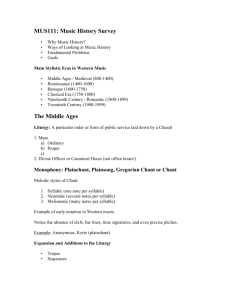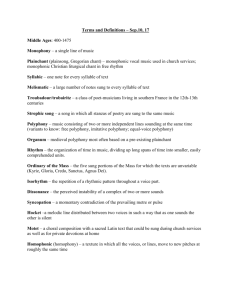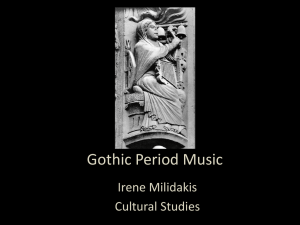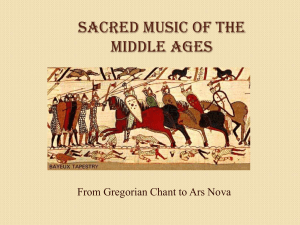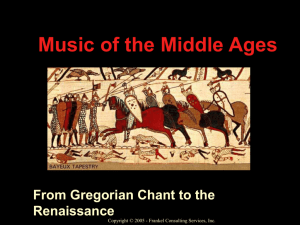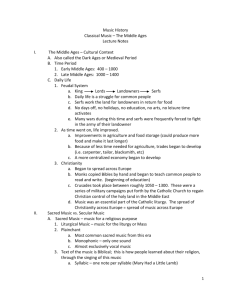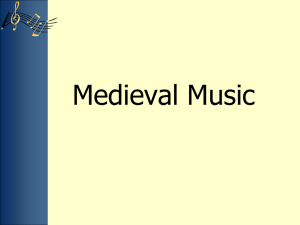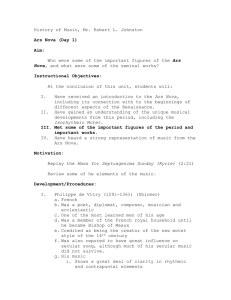Lecture 5 Early Music
advertisement
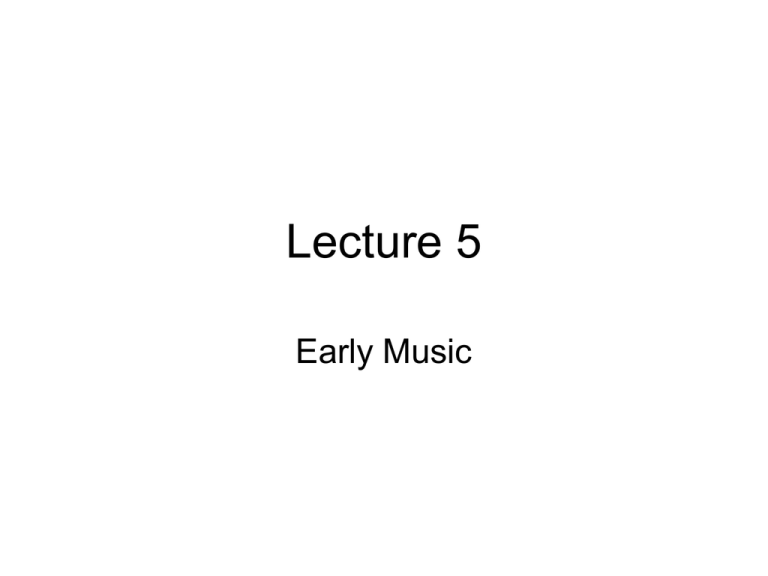
Lecture 5 Early Music Terms • • • • • • • • • • Minnesingers alba pastourelle strophic form estampies organum melismas motet Ars antiqua Ars nova More Terms • ars • isorhythm • hocket Objectives • Hear how elements and structures of music were typically used in the Middle Ages • Identify and follow principle types of music written in the Middle Ages: plainchant, troubadour songs, Notre Dame organum, and ars nova motets When? • 476 C.E. (A.D.) or the fall of the Roman Empire to 1400. • What do you know about this period? • Seen anything in movies? Stuff you should know • Europe was invaded all the time. Huns, Goths, Vikings, Mongols, Islamic armies. • European access to international commerce and communication dropped off. • So the economy shifted to feudalism • Mass migration, invasions, famine, plagues. • Average person lived in primitive brutal conditions • Greco-Roman advances lost. General Observation • Polyphony and music notation were the major musical achievements of the era. Plainchant • Roman Catholic Church was the primary patron of all things musical. • Standardized liturgy led to a standardized was of writing music, called notation. • By 1000 music was notated. • Singing heightened speech to the glory of God. Plainchant Characteristics • Called “plain” because it is an unaccompanied, monophonic, unmetered, and non-rhythmic. • Not constructed on major/minor system • Modes around D(Dorian), E(Phrygian), F(Lydian), G(Mixolydian). • Describe the mood of In Paradisum • Look for characteristic uses of musical elements. Characteristics • • • • • Smooth legato melody Moderate dynamic level Monophony Easy tempo Mode is Mixolydian But what is most striking is what is not there . . . • Lack of meter • Lack of strong cadences • Lack of clear symmetrical phrase relationships • Creates floating otherworldlyness, passionate yet serene. Next . . . Recitation • Vere dignum • Simplification of melody. • Text is more important rather than mood. • Greater rhythmic feeling. • Solo. • Mode is Dorian Plainchant sequence • Columba aspexit • Series of short melodies sung twice. Once by the soloist, once by the choir and modified. • Drone. • A A’ Music at Court • 12th and 13th century. • Troubadours in southern France, Trovères in northern France and Minnesingers in Germany. All were of noble birth • Jongleurs were song writers of common station. • Alba was a “dawn song”. • Pastourelle, seduction song of knight on horseback and a maiden. Evolution of Polyphony • Organum is the earliest type of polyphony (900) • Tradition plainchant with another person singing a different tune at the same time to the same words. • Polyphony “evolved” in the period between 1000-1200 Evolution • Each note accompanied by another single note (counterpoint). Parallel organum. Same interval same melody. • Then the lines became more independent • Then they started to embellish. The embellishments became so many that the original tune became long a drawn out. • Then two counterpoints were added. • Then then it was metered The two organum guys in Paris, 1163-1235. • • • • Léonin Pérotin Lets listen to Alleluia. Diffusa gratia. Melisma Later Medieval Polyphony • After 1200 polyphony distanced itself from the church. • Upper lines given their own words. Now they were called a Motet from the french word ‘mot or word. Ars Nova • Started around 1300 with “new heights” of sophistication in motet writing. • This motet writing was known as the “new technique” or Ars Nova and the old was organum or Ars Antiqua. • Turbulent time in the world • Rhythm was the main pre-occupation of the composers most notably . . . Guillaume de Machaut (c.1300-1377) • The Motet “Quant et moi” • Based on plainchant, played underneath the singers in this case by a viol. • Isorhythm-successive lengthy passages to identical rhythms but to different melodies. • Hocket is a hiccup.
